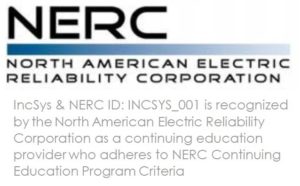 Voltage & Reactive Power Control
Voltage & Reactive Power Control
Course NERC Continued Educational Hours: OT: 10; Stand: 5; SIM: 4.5
This is a NERC Continued Educational computer-based training module which consists of several video lectures and simulation exercises. The Instructor presents lectures on the reactive power, the real and reactive power triangle and waveforms, static and dynamic MVAR resource, MVAR characteristics on line and voltage collapse in radial systems. Instructor presents lecture on high and low voltage limits and how a large Reliability Coordinator categorizes these limits along with appropriate corrective actions and timeframes. Pole and beam analogy for understanding voltage and MVAR characteristics in a network. Students learn to recognize when a network may be vulnerable to voltage collapse and they are also shown how to calculate MVAR reserves in vulnerable areas while learning about Automatic Voltage Regulator operation. Students will identify the limiting elements of the Steam and Hydro Generator MVAR Capability Curves. NERC standards VAR-001 and VAR-002 are covered for the role transmission operators and generator operators play in maintaining voltage schedules and students will observe the voltage and megavar characteristics of generators in the simulator by adjusting AVR voltage setpoints and monitoring MVAR output and terminal voltages. They will also observe the effects of switching AVRs from AUTO to MAN mode while applying the NERC standards VAR-001 and VAR-002. Instructor presents a lecture on transmission line Surge Impedance Loading, Ferranti rise and effects of heavy transmission line loads on bus voltages. Students will operating the simulator according to the NERC standards IRO-008 and TOP-001 and determine the maximum power transfer on a path when a line has voltage support at both ends while monitoring line MVAR flows and detect when it is operating at the SIL. The instructor presents a lecture on shunt capacitors, reactors and Static VAR Systems (SVS)and students will learn about the purpose, application, and construction of shunt capacitors, shunt reactors and SVS. Students learn the different failure modes of capacitors, back-to-back switching, and trapped charge as well as the concept of “Getting Ahead of the Voltage”. Students learn about the purpose, application, and construction of static var compensators, including transmission, industrial, and wind farm applications and also learn about transformers and their role in transmission networks, the various types of transformers, their construction, and the principles of operations. Instructor presents a lecture on construction and operation of tap changers and how to use tap changers to control voltage where they will learn different methods of cooling transformers and the impact they have on transformer operation and how they tie into a SCADA system.
PALCO 500 – Course Objectives
Voltage & Reactive Power Control
- Describe real & reactive, power factor and the power triangle.
- Describe MVAR characteristics on transmission lines, angle differences, and voltage magnitude
- List causes & effects of low & high voltages on customer loads, winding insulation and transformers
- Describe the categories of voltage limits, timeframes, and corrective actions
- Identify strong and weak buses and anticipate voltage based on inductors, capacitors and loads in a network
- Apply a pole and beam analogy to identify weak and strong buses in an interconnection
- Anticipate how bus voltage varies with inductors, capacitors, and MW loads in the network
- Describe the nature and dispatch of MVAR reserves and how to anticipate severe over voltage conditions and the isolating effects of generators
- Describe Automatic Voltage Regulator operation and the role of generators in voltage control
- Identify the limiting elements of the steam generator MVAR capability curve and the hydro generator MVAR capability curve
- Describe how generator regulated voltage schedules need to be coordinated
- Summarize the NERC standards for generator operators in maintaining voltage schedules
- Observe voltage and MVAR characteristics of generators
- Operate the simulator to adjust voltage setpoints and predict MVAR output and terminal voltages
- Observe the effects of automatic voltage regulators on generating units
- Explain the concept of Surge Impedance Loading and how transmission lines can act as capacitors or reactors
- Describe the relationship between MVARs and MW loading on transmission lines
- Define Ferranti rise and explain its effect in open ended lines
- Describe the effects of heavy transmission line loads on bus voltage
- Observe the voltage and MVAR characteristics of transmissions line in a simulated power system
- Identify overloaded transmission lines and explain the effects of tripped lines on the system
- Plan and implement post-contingency corrective actions
- Observe the effect of raising voltage at the sending end of a transmission line by adding reactive load to a radial bus
- Define the purpose, application, and construction of shunt capacitors, shunt reactors, and Static VAR Systems (SVS)
- List the different failure modes of capacitors
- Explain the effects of back-to-back switching and trapped charge
- Describe and observe the effect of shunt capacitors on a weak bus
- Explain the practice of placing shunt capacitors next to generators
- Explain the concept of “Getting Ahead of the Voltage:
- Explain the roles of static VAR compensators in transmission, industrial, and wind farm applications
- Use shunt capacitors and reactors to control voltages in a power system under light and heavy load conditions
- Describe the role of transformers in transmission networks
- List the different types of transformers, explain their construction, and the principles of operation
- Identify 3-phase winding configurations of different transformers
- Describe the construction and internal operation of tap changers
- Classify the types of tap changers and the principles of operation for each (GSU, EHV-HV, HV-MV)
- Explain the application of tap changers to control voltage
- Identify the different methods of cooling transformers and describe their transformer operation
- Identify different types of temperature indications and how they relate to power operations
- Operate tap changers in a simulated power system and observe system conditions as the changers are manipulated
- Identify strong buses and weak buses depending on system conditions
- Anticipate load pickup based on time and day to create plans to prepare for increased load
- Observe system conditions and develop explanations for voltage collapse conditions
- Explain the sensitivity of motor and non-motor loads to voltage
- Describe how Fault Induced Delayed Voltage Recovery occurs
- Describe typical values of power factor for various types of loads
- On a simulated power system, select the specific control actions that will reduce the risk of voltage collapse and cascading outages
- Observe and characterize system conditions following a triple contingency on a simulated power system
- Identify which generating units are near their MVAR limits
- Analyze the impact of changing tap changers following a contingency
- Maintain system stability by shedding load, decreasing the interchange schedule, and reducing overloads as necessary
- Restore the power system to normal operation
Downloadable PALCO 500 Course Flyer
Subject Matter Expert
This course listed is a NERC CE approved continuing education course which will help you obtain the required NERC CE Credit Hours for maintaining the validity of your NERC Certification.
End of Course Instructions
After successful completion of the course the certificate of completion will be available for download and print from your training homepage.
After successful completion of this course your credits will be automatically reported for NERC CE Credits via the NERC SOCCED reporting tool. IncSys Academy also has a policy where credits will be manually reported via SOCCED on a WEEKLY basis (every Monday). It is critical that each candidate provide IncSys Academy with their proper credentials to ensure that proper credits are reported to your SOCCED account. Please contact our team at 425.732.2377 X 3 or via email at calvin.kaiser@incsys.com to report any NERC CE credit items needed for resolution.
Quiz & Simulation Information
There are quizzes and simulation exercises in this course module which must be passed with a MINIMUM grade of 75% to complete the course. Please check your grade report to ensure that you have achieved a passing grade of at least a 75% for each graded area.
IncSys Non-Refundable Policy
Clients who purchase training from the IncSys Academy catalog portal are Non-Refundable from the date of payment. Please ensure that you copy and save your receipt order prior to closing out your purchase order payment.
